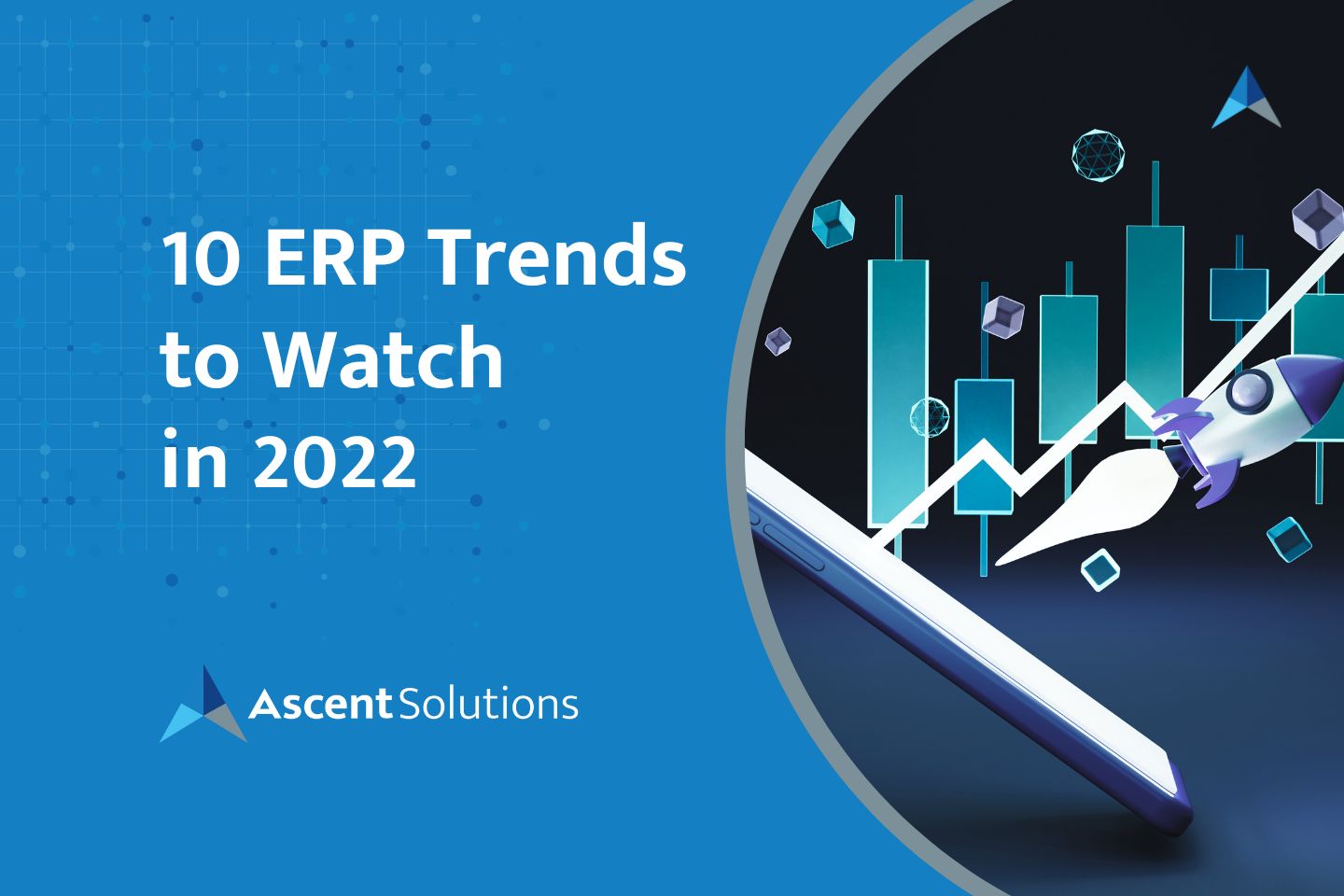10 ERP Trends to Watch in 2022
View All: Resources

Charting the Course: Anticipated ERP Trends for 2022 and Enhancing Strategies for Sustainable Growth
It’s time to gear up for another exciting year in the world of enterprise resource planning (ERP). Consumer purchasing habits have begun to stabilize and the SMB and enterprise companies that provide B2C, B2B, and B2B2C products continue to test and optimize new ways to meet fluctuations in demand while attempting to keep customers happy and loyal. With global supply chain issues expected well into 2022, we’d like to provide an ERP technology enthusiast perspective on the 10 ERP trends we expect to see in 2022. Our goal is to help complement an existing ERP strategy to fill any gaps using technology to drive incremental revenue and lower operational costs. Without further ado:
Ascent Solutions 10 ERP Trends to Watch in 2022
The New Economy is here to stay. The pandemic completely shifted the way consumers want to find, purchase, and receive products. The pre-pandemic momentum of brick-and-mortar + online retail was quickly halted. Online and mobile-only shopping filled this gap, as expected, but consumer demand for same-day shipping (i.e. the Amazon effect) intensified, which caused companies to scramble for new approaches in supply chain management, fulfillment, and logistics. We expect companies to innovate further here using technology to better manage closed-loop commerce.
Last-mile fulfillment becomes a larger focus for SMB companies. We blogged about microfulfillment last year and think the trend will be even bigger in 2022. The shift from large warehouses and distribution centers hours away from metropolitan centers, to downtown, smaller locations, enabled companies to meet new consumer delivery demands. With the bar for customer brand switching being lowered dramatically without brick-and-mortar experiences, it became critical for companies to innovate in the last mile using a new fulfillment center model. We expect more companies to adopt this approach.
Omnichannel commerce expands into new areas. Just a few years ago, omnichannel commerce was the focus for companies that needed new ways to acquire customers using multiple marketing channels. Teams spent considerable time and budget on digital advertising, social media, e-commerce websites, email marketing, and direct mail to convert shoppers. What’s changed recently is the growth of customer service within the omnichannel commerce toolkit. Customer satisfaction and loyalty are more critical than ever, and companies will continue to double down on CSRs, and technology and even add high-touch services such as in-home delivery while you’re out grabbing a coffee.
Companies finally focus on reverse logistics in 2022. Reverse logistics or customer returns, is the process companies use to handle inquiries after the point of sale that often lead to returned inventory. The customer return process is wildly inefficient today and is a massive opportunity for companies that want to lower costs, improve lifetime customer value, and loyalty. We believe more companies will make investments in technology and teams to improve reverse logistics, using it as a strategic differentiator versus competitors that are eating the costs of returns because it’s too complex to manage well.
“Click and Collect” becomes the next battleground for retail business. While companies now have a more dialled-in process for mobile shopping and doorstep delivery, the trend of customers ordering online and picking up at the storefront (i.e. Click and Collect) is rising. There are significant operational implications for store employees who now must pick, pack and “ship” products to the curbside. Walmart has become a leader in Click and Collect and we expect smaller companies to follow suit in order to increase customer loyalty in a switch-happy world.
Supply chain complexity requires additional investment in new tools and technologies. As companies battle global supply chain issues, a unique need has arisen. That is, the need for all stakeholders to have real-time visibility into the product journey. Companies must now provide insights for partners, employees, and customers as stakeholders want to know where the bottlenecks are in the supply chain when the inventory will arrive in the microfulfilllment center, at the customer’s doorstep, or back to the warehouse for a returned item. This desire for end-to-end visibility is a powerful use case for technology that helps better manage inventory and provides real-time visibility down to the palette on a delivery truck or SKU in the warehouse.
Stakeholder visibility leads us to “Community 360”. Salesforce has talked about “Customer 360” for quite a while, which is the concept of unifying business teams around the customer, to delight customers and drive more business value. We think this concept will evolve into “Community 360” or something similar. Why? Delighting customers simply isn’t enough anymore. Not in this new world of value chain complexity. Now, companies must delight customers, partners (e.g. suppliers, distributors, manufacturers), employees, and investors. These critical stakeholders all want more visibility into products/inventory and operations, in real time. This concept creates a new Venn diagram of stakeholders in the center and you’ll see a renewed focus on technology to provide community-based solutions.
New industries innovate in ERP using technology. We’re seeing more customers from non-traditional industries looking to innovate in ERP through technology. Whether it’s energy, cannabis, or other industries, we think 2022 will be the year more companies look to innovate using cloud technology to support complex inventory needs.
Companies invest in more hardware for “equipmentization.” Whether it’s mobile warehouse scanners, point of sales (POS) systems, curbside check-in devices, or other technology, we see the trend of “equipmentization” growing in 2022. Employees and customers need new tools to purchase, receive, and return products. New startups and industry leaders like Zebra Technologies will continue to innovate and provide more solutions to enable this approach.
Major technology players provide more platform integrations. While large technology providers don’t always partner and integrate well, we think more companies like Salesforce, Shopify, Amazon, Walmart, etc. will see the value enterprise peers, along with growing startups, provide in the ERP process. This will lead to a wave of deeper partnerships, acquisitions, and integrations to empower communities to use the technology platforms of their choice for a better experience.
Did we miss any trends that you think will be impactful this year? Let us know and make sure to check out our 100% native Salesforce applications on the AppExchange, if you’d like to learn more about our technology solutions for these ERP trends.
Follow Us
Have questions? We can help!
Ascent Solutions will provide you with ultimate customer service, attending to all of your needs promptly and efficiently. Our goal is to serve as your partner so that all of your needs are met in accordance with your schedule and align with your budget.
- Call Us: 908-981-0150
- Ascent: Contact Us
Related Posts
Categories
Why Ascent?
We are distribution and manufacturing technology enthusiasts that understood the term “ERP” was oversold and under delivered. We designed a flexible platform to ensure that we are able to adapt and evolve with businesses from the startup to enterprise level yet keep our offering affordable.




